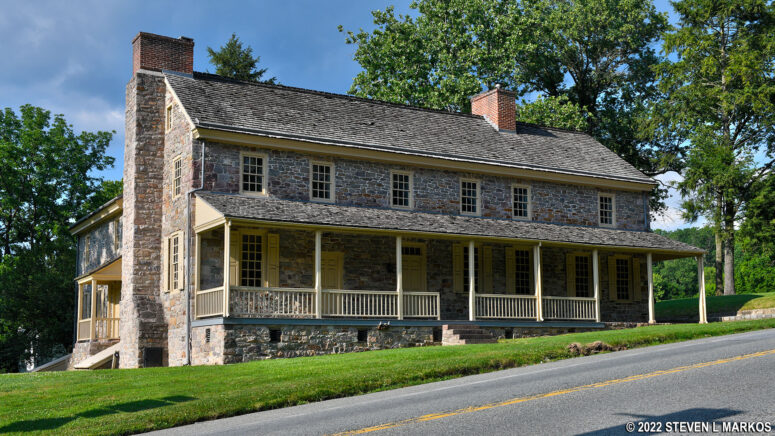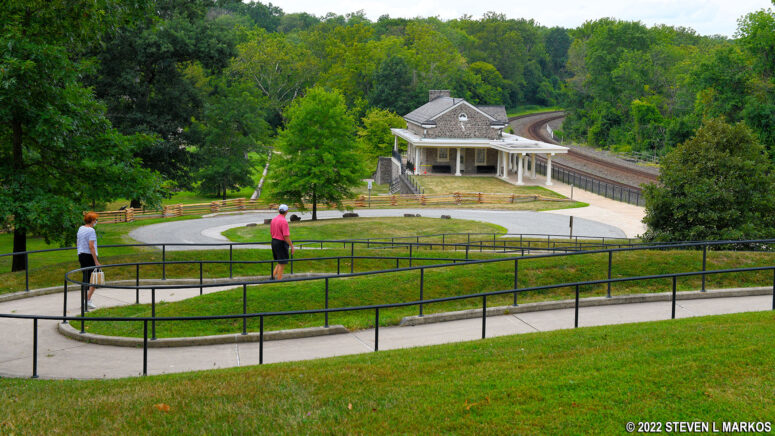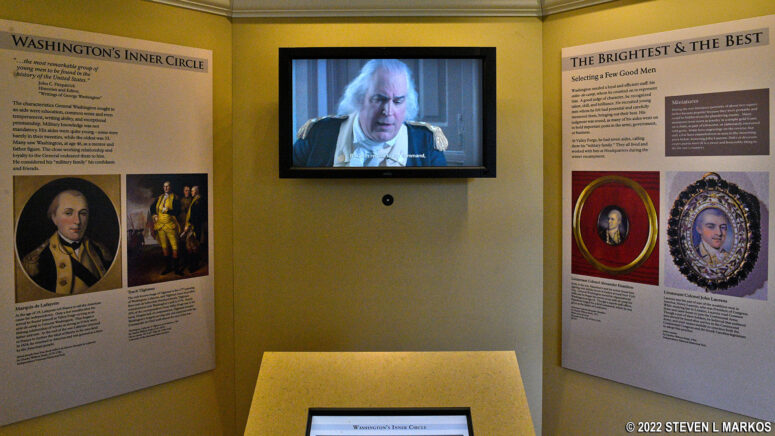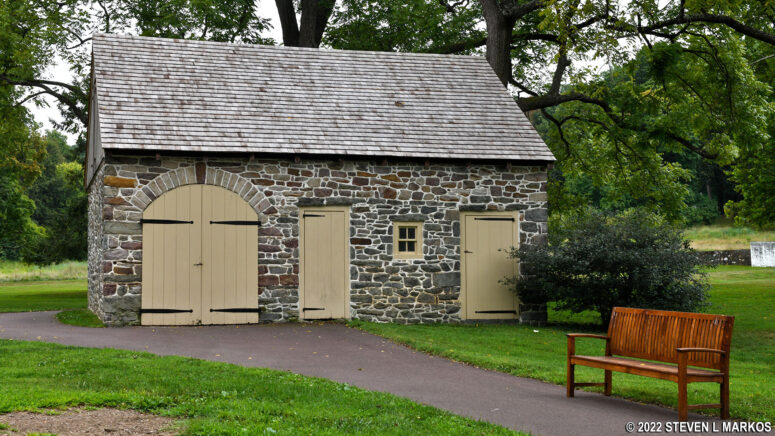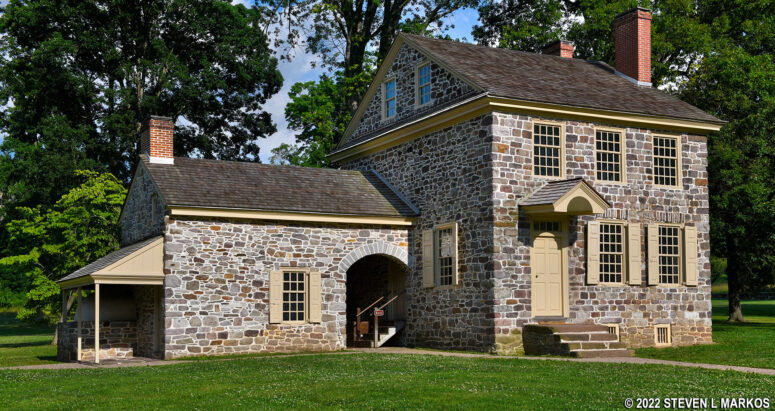VALLEY FORGE ENCAMPMENT TOUR STOP 5
Washington’s Headquarters
OPERATING HOURS AND DIRECTIONS
The fifth stop on the Valley Forge Encampment Tour is George Washington’s Headquarters. There are many attractions at this stop, with the most interesting being the Isaac Potts House where Washington stayed and the Valley Forge Train Station. Both open to the public, with hours depending on the season. Rangers are on duty to answer questions. For the current schedule, see the National Park Service’s official Operating Hours and Seasons web page for Valley Forge National Historical Park. If the Potts House and train station are open, you could easily spend an hour or more at Washington’s Headquarters. If everything is closed, plan to spend 30 minutes for your visit.
When approaching the Washington’s Headquarters property from Valley Creek Road, you will see the buildings long before the parking lot. The road dead ends in front of an old house, the David Potts House (aka The Bake House). Behind it is Isaac Potts’s property and home. You’ll be wondering how in the world to get to it since there is no parking in sight. Take a right on Hwy 23 / Valley Forge Road. It will appear as if you are driving away from Washington’s Headquarters, but just keep going until you come to the next road on your left, River Road. Turn here; the road ends at the parking lot. If you are doing the Valley Forge Encampment Tour on bike or foot by following the Joseph Plumb Martin Trail, while the main trail does not pass Washington’s Headquarters, there is a spur trail near Varnum’s Quarters that takes you to it. The distance to the parking lot is a little over a half mile.
WASHINGTON’S HEADQUARTERS HISTORY
While the common soldiers of the Continental Army were freezing their butts off in quickly thrown together log cabins at Valley Forge during the winter of 1777-78, General George Washington and his staff were holed up in the home of Isaac Potts. Washington did pay a rental fee to Potts’s aunt, Deborah Hewes, who was renting from Potts at the time (thus Washington was subletting the house).
The Potts Family was a wealthy Valley Forge family whose money came from the iron business. An iron forge—the Mount Joy Forge—had been operating along Valley Creek since 1742. John Potts (Pottsville, Pennsylvania was named after him) purchased the forge in 1757 and expanded it. His son Joseph acquired the forge in 1768 after his death. Joseph later sold it to his brother David. Isaac Potts purchased the property now known as Washington’s Headquarters from Joseph in 1773. The house and two mills were on the property at the time.
David partnered with William Dewees Jr. to operate the original iron forge, and they opened a second forge circa 1775. The new forge (Upper Forge) was located farther south on Valley Creek from the Isaac Potts property, and the original forge (Lower Forge) was located closer to the property (near the intersection of today’s Valley Creek Road and Valley Forge Road). Valley Creek flows south to north, so downriver (lower) is closer to the Potts property. (Note: historians have differing opinions as to which was the original forge and which was the new forge, and some argue that the new forge was built after the American Revolution.)
In March 1777, Potts and Dewees agreed to let the Continental Army use the original Mount Joy forge buildings to store supplies, though they were afraid the British would hear about it and raid the place—which is exactly what happened. On September 18, 1777, British troops showed up, pilfered the supplies, burned the forge to the ground, and blew up the dam that provided water. (Historians who argue that the Upper Forge existed at the time also believe it was destroyed.)
After the war, the lower forge was rebuilt by Isaac, his brother David, and William Dewees. Isaac acquired a majority interest in the forge in 1784, but by then business was slowing. He tried unsuccessfully to sell it in 1790, finally doing so in 1793. The new owner, Jacob Paul, operated the forge for another 24 years. By then, coal was being mined closer to more populated areas, and there was no longer a need for rural forges that relied on access to large swaths of forest to produce charcoal needed as a source of heat to operate the forges.
As mentioned, Washington was not the only person to occupy the Potts House. His military aides and staff, housekeepers, cooks, and maids (slaves and free workers) also lived there. Even his wife, Martha, stayed with him beginning in February 1778. At its peak, as many as 25 people called the Potts House home. It was so crowded that Washington eventually had a log cabin built next to it that he used for dining with his officers and to get away from the chaos of the main house (the cabin no longer exists).
The Potts House remained a family residence of various owners until it was purchased in 1879 by William Holstein, whose wife Anna was a regent of the Centennial and Memorial Association of Valley Forge. The Holsteins transferred the property to the Association in 1886 for the purpose of restoring and preserving it for posterity. The state of Pennsylvania purchased the house for Valley Forge State Park in 1905 (the park opened in 1893). It became federal property in 1976 when Valley Forge National Historical Park was created.
TOURING WASHINGTON’S HEADQUARTERS
The first thing to know about Washington’s Headquarters is that the parking lot is a good ways from the attractions, plus it is high above the Potts property. The path down to the site is quite steep, but there is a road you can take to the bottom in your vehicle for the purpose of dropping off passengers. However, you cannot park there, not even if you have a handicap parking permit.
The Washington’s Headquarters area is quite large, and there are many points of interest. In fact, there is more to see and do here than at any other stop on the Valley Forge Encampment Tour. A handicap-accessible paved walkway connects all the attractions. You’ll end up walking a little over a half mile during your visit.
The building you see as you walk down from the parking lot is not the Potts House but a train station that was built in 1911 by the Philadelphia and Reading Railroad in the same style as the Potts House. Its purpose was to bring tourists to Valley Forge State Park, and it served as the park entrance until operations ceased in 1960. The depot was still owned by the railroad, but it sat empty until the late 1990s, at which time the railroad donated it to the park. It now houses a small museum and is typically open whenever the Potts House is open. To read all the information and watch the two videos that show on demand takes about a half hour.
The Valley Forge Train Station Museum has two exhibit areas. One is the train station ticket office. Here you will find an information panel on the history of the train station and some antique equipment.

Antique equipment on exhibit at the Valley Forge Train Station, Valley Forge National Historical Park
The second room contains information panels that focus on the VIPs that made Valley Forge home during the winter of 1777-78. Topics include Washington and his accomplishments at Valley Forge; Friedrich Wilhelm Baron von Steuben and his standardization of training methods and overhauling of the way camps were laid out, making them more hygienic; Washington’s inner circle of staff that included, in addition to von Steuben, Alexander Hamilton, John Laurens, Tench Tilgham, and Marquis de Lafayette; and his wife, Martha, and the domestic staff that stayed with him at the Potts House, some of whom were slaves. There are two videos that run around five minutes each and an interactive touch-screen computer with more information about Washington’s inner circle members.
There is also an exhibit on how the Potts House and out buildings at Washington’s Headquarters were restored. The exhibit includes artifacts found on the property during various excavations carried out over the years since Valley Forge first became a state park in 1893.
To tour the Washington’s Headquarters area, you can either take a left on the path prior to the Valley Forge Train Station and proceed around the property in a clockwise manner or enter the train station platform and walk to the end where you will find stairs and a wheelchair accessible ramp that leads to the path that will send you off in the counterclockwise direction. If you opt to go clockwise as I did, the first stop is at a group of historically reconstructed soldier cabins, the same as those at the Muhlenberg Brigade stop on the Valley Forge Encampment Tour. These cabins would have been occupied by the Commander-in-Chief’s Guards, a hand-selected military unit that protected Washington, his family, and his belongings. In addition to the cabins is a building partially buried in the ground. This is a restoration of a spring house used by the Potts Family to keep food items cold. It is doubtful that Washington and his men had any use for it when they camped during the winter at Valley Forge.
The next stop is at a bronze statue of George Washington. This is a copy of a marble statue originally erected in 1796 in the rotunda of the Virginia State capitol building.
Just past the Washington statue is a stone stable / carriage house and a large, white building. The stable existed when Washington stayed on the property, though all that survives today is the foundation and small bits of the walls; the rest is a reconstruction. In the 1920s it served as a Washington’s Headquarters museum. Today it houses an exhibit about the 18th century iron industry at Valley Forge. It takes about then minutes to read all of the information if you care to do so. The history of the forges is very interesting.
The white building is a stone barn that was most likely built after the Revolution. There was a barn on this spot in 1777, but it is unknown if the current building is this barn or if it is a replacement for an older barn. Construction techniques date it anywhere from 1770 to 1840. It may have been used as a dormitory for mill workers (there was a grist mill on the property when Washington occupied the Potts House). It was renovated into park offices in the 1920s and today serves as a maintenance building.
The final stop is at the Potts House where George Washington made his headquarters when he stayed at Valley Forge. The house has been modified over the years, including during the time it was part of Valley Forge State Park. The larger section of the house hasn’t changed much, if at all. It’s the small addition on the north side—the kitchen—that has been modified many times over the years. A photo from 1861 shows it as a two-story structure, and there was an additional two-story ell attached to it. A photo from 1905 shows the house close to how it appears today, with the kitchen reduced to one story. Oddly enough, it was back to two stories in a 1960s photo, meaning that somewhere along the line historians determined that the kitchen was two stories when Washington was there. Historians changed their minds quickly thereafter, as the top story was removed once again in 1975. No further modifications have been done since 1976 when Valley Forge National Historical Park was created.
When open, visitors are welcome to look around inside. There are two rooms on the first floor, three on the second, and an attic space. There are no information panels that identify the rooms, so other than taking a look and snapping a few photos, there’s not much to it. You could be in-and-out in five minutes if you don’t stop to talk with a Ranger, which is the only way to get information about the house.
Rooms are furnished as they might have been when George Washington was there. The furnishings are not original. Some are faithful reproductions of items known to have belonged to Washington, and others are furnishings common to the time period. The house itself is thought to be 90 percent original.
The following are interior photos of the Potts House. Note that nobody really knows which rooms were used for offices and which were used for bedrooms. Most likely the layout changed often to accommodate people coming and going during the Valley Forge encampment.
Tour Stop 6 | Tour Stop 4 | Encampment Tour Main Page
With a few exceptions, use of any photograph on the National Park Planner website requires a paid Royalty Free Editorial Use License or Commercial Use License. See the Photo Usage page for details.
Last updated on August 5, 2022



